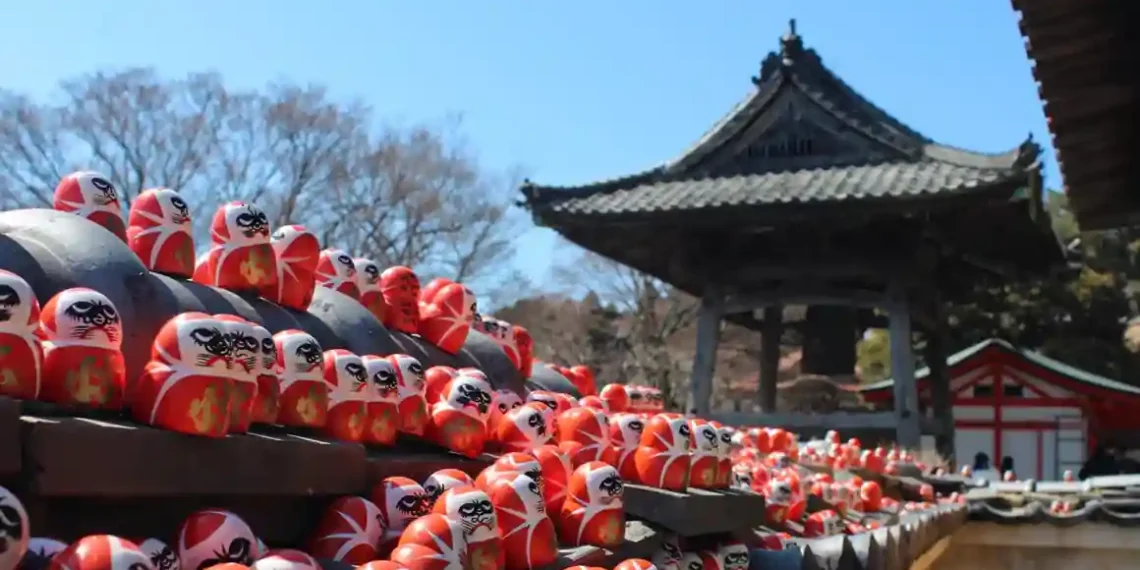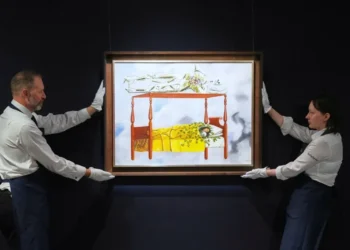The Enduring Charm of Japan’s Daruma Dolls: A Symbol of Determination and Success
When you step into the serene grounds of Katsuo-ji Temple, one of Japan’s most beloved landmarks, you can’t help but notice the sea of Daruma dolls scattered across the hillside. From the towering figures peering out from between tree branches to smaller versions perched on altars, these iconic red dolls are impossible to miss.
Located in the scenic Minoh National Park, just an hour outside Osaka, Katsuo-ji Temple has long been associated with success and victory. The temple’s history stretches over 1,300 years, and for the past century, it has been home to thousands of these talismans, which have become a cherished symbol of perseverance and good fortune across Japan.
Katsuo-ji is affectionately known as the “Daruma Temple”—a name that dates back about 100 years, when the temple began selling these lucky charms. The Daruma doll, a vibrant reminder of Japan’s culture and traditions, represents Bodhidharma, the 5th-century monk who founded Zen Buddhism. Legend has it that Bodhidharma meditated for years so intensely that he lost his limbs, an image captured in the doll’s rounded, weighted form that always returns upright when toppled—symbolizing resilience and unwavering determination.
For centuries, Katsuo-ji has been a spiritual retreat for emperors, shoguns, and ordinary people alike, all seeking blessings for victory in battles, exams, and business ventures. Even today, locals flock to the temple before major events, such as exams or important meetings, hoping for a boost of luck.
Unlike other lucky charms that promise wishes granted with little effort, the Daruma doll encourages an active role in achieving one’s goals. According to Marco Fasano, an Italian tour guide and founder of Tanuki Stories, the process of acquiring a Daruma is an interactive ritual that goes beyond simply making a wish.
“First, you think of a goal you want to accomplish, then you write your wish on the doll and paint one eye. You purify the Daruma with incense before taking it home with you,” Fasano explains. The key to the Daruma is constant reflection: every time you look at it, you’re reminded of your goal and asked, “What can I do today to get closer to achieving this?” The second eye is filled in only once the goal is achieved—a powerful symbol of hard work paying off.
Fasano’s own experience with the Daruma was deeply personal, having visited Katsuo-ji before taking his Japanese Language Proficiency Test. He emphasizes that the process isn’t just about passive hope—it’s about taking action.
“When you see so many people returning to the temple with completed goals, it’s a tangible reminder that you too can achieve your dreams if you put in the effort,” he says.
The Daruma doll’s distinct look—a round body, scowling face, and wide eyes—holds a wealth of symbolism. It’s not just about resilience. The doll’s thick eyebrows and beard represent cranes and turtles, animals revered for their association with longevity and good fortune in Japan. The bright red color further amplifies its auspicious significance, as red is considered a color of protection.
Beyond Katsuo-ji, Daruma dolls are also deeply embedded in other parts of Japan, including nearby Kyoto’s Hōrin-ji Temple, known as “Darumadera.” However, the heart of Daruma production lies in Takasaki, a town in the Gunma Prefecture, where about 80% of the dolls are crafted. The tradition there goes back over 200 years, with the Shorinzan Daruma-ji Temple starting the practice of selling them over two centuries ago.
At Katsuo-ji, visitors can choose between two types of Daruma: the Kachi-Daruma, or “winning Daruma,” for those setting specific goals, and the Daruma-Mikuji, or “fortune-telling Daruma,” unique to this temple. Instead of painting eyes, those who choose a Daruma-Mikuji ask a question before selecting their doll, which contains a scroll offering guidance to help them along their journey.
Despite the influx of millions of visitors to Japan each year, Katsuo-ji remains a somewhat hidden treasure. While Osaka is a bustling hub for tourists, the temple sees far fewer visitors compared to the likes of Asakusa Senso-Ji in Tokyo, which attracts around 30 million people annually. Katsuo-ji’s annual visitor count hovers between 800,000 and 1 million, with a significant portion of those visitors coming from overseas.
Fasano, who has lived in Osaka since 2023, believes that the city and its surrounding areas deserve more attention from tourists. “Osaka is often underrated. People think there’s nothing to do, but there are so many unique spots, like Katsuo-ji, that offer a richer cultural experience,” he says.
To attract more visitors and offer a deeper connection with the Daruma tradition, Katsuo-ji introduced a creative “stamp rally” in May 2024. This activity encourages visitors to explore the temple grounds, collecting stamps at six checkpoints that form an image—a metaphor for goal-setting, one step at a time.
For visitors, purchasing a Daruma at Katsuo-ji adds a layer of meaning to the experience. “Buying a Daruma here feels more powerful than picking one up in a random shop,” Fasano reflects. “It’s a reminder that achieving your goals is a journey—and you have to be intentional about each step.”
Daruma dolls have evolved into one of Japan’s most beloved souvenirs, symbolizing not just luck, but a call to action and perseverance. At Katsuo-ji, surrounded by the whispers of centuries-old prayers and the encouragement of countless others who have made their wishes, the Daruma doll becomes much more than a simple token. It serves as a companion in the quest for success—a reminder that while luck plays a part, true achievement requires effort, reflection, and determination.
This article was rewritten by JournosNews.com based on verified reporting from trusted sources. The content has been independently reviewed, fact-checked, and edited for accuracy, neutrality, tone, and global readability in accordance with Google News and AdSense standards.
All opinions, quotes, or statements from contributors, experts, or sourced organizations do not necessarily reflect the views of JournosNews.com. JournosNews.com maintains full editorial independence from any external funders, sponsors, or organizations.
Stay informed with JournosNews.com — your trusted source for verified global reporting and in-depth analysis. Follow us on Google News, BlueSky, and X for real-time updates.














